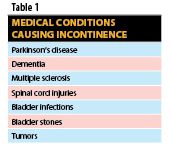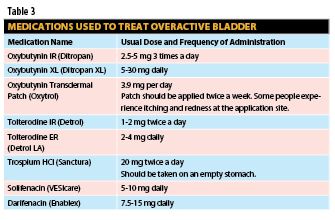Article
Going Against the Flow: Treating Overactive Bladder
The impact of overactive bladder on quality of life is a major concern and pharmacists can help patients with this common condition.
The impact of overactive bladder on quality of life is a major concern and pharmacists can help patients with this common condition.
Overactive bladder (OAB) is a common, but embarrassing and often underreported, medical condition. OAB is estimated to affect 200 million people worldwide. An estimated 25 million American adults are thought to experience symptoms of OAB and urinary incontinence. Approximately 75% of people with OAB are thought to be women.
Symptoms of incontinence are sometimes connected with increasing age, but OAB is not a “usual” aspect of aging and may require medical attention. The symptoms of OAB are caused by involuntary bladder muscle contractions. These muscle contractions can result in a sudden urge to urinate, more frequent daytime or nighttime urination, or urine leakage during physical activity. OAB may be caused by underlying medical problems or certain medications. Table 1 lists a few of the many medical conditions that can result in symptoms of OAB. Table 2 lists factors that may contribute to worsening symptoms of OAB.
Treating OAB
The impact of OAB on a person’s quality of life and daily functioning is a major concern. There are numerous treatment options available, including lifestyle changes and medications. If you think you may have OAB, seek the advice of a physician as a first step. A qualified health care professional can recommend which treatment would be best.

Lifestyle Changes
Changes in behavior or lifestyle may be recommended for individuals experiencing symptoms of OAB. These changes do not require the use of medications and are virtually free of side effects. Behavior modifications include using the toilet at scheduled times, changing diet and lifestyle to cope with symptoms of incontinence, and using techniques to exercise the pelvic floor muscles, such as Kegel exercises. Implementing these changes in your daily routine may increase the time between toileting and improve symptoms of urinary urgency.
Quitting smoking and decreasing caffeine intake are important diet and lifestyle measures individuals can take to alleviate OAB symptoms. People who smoke more than 15 cigarettes per day are 2.8 times more likely to experience urinary incontinence. Limiting caffeinated beverages and watching your daily fluid intake may also help improve OAB symptoms. According to one report, individuals who drink 2½ cups of coffee per day or more may be more likely to experience symptoms of OAB. In individuals who are overweight, attempting weight loss and incorporating a daily exercise routine with the guidance of a doctor may improve lower urinary tract symptoms.

Pelvic floor muscle exercises have also been shown to significantly improve the quality of life in individuals suffering from OAB. Dr. Kegel first introduced these exercises in 1948 for the treatment of urinary conditions, stating an 84% cure rate in symptoms. With the advancements in today’s technology, electrical stimulation of the bladder muscles under a doctor’s care can result in more complete bladder emptying and filling. Patients who consistently used this technique over a 12-week period discovered a 51.4% decrease in OAB symptoms.
Absorbent undergarments are available over the counter to help cope with any leakage issues individuals with OAB may experience. Pharmacists can offer assistance in the selection of appropriate products.
Medications

Oxybutynin (Gelnique) is a transdermal gel that can be applied only once a day to areas such as the shoulder, upper arm, abdomen, and thigh. This application delivers 4 mg of oxybutynin and has been shown to decrease the number of urinations per day. In comparison with the oxybutynin transdermal patch, this gel formulation causes less irritation to the skin where it is being applied.
Fesoterodine (Toviaz) is a fairly new medication available in 4- and 8-mg doses taken once a day. The higher dose, although more effective, does have more dry mouth side effects. Even though more dry mouth side effects are seen with the higher dose, overall side effects are less likely with this drug compared with others. It is important to avoid the consumption of alcohol with this medication.
Trospium chloride has also been developed into a once-daily extended-release formulation. Trospium chloride XR (Sanctura XR) has a lower incidence of dry mouth compared with other medicines in this class.
It is important that people with OAB speak with their doctor or pharmacist about other medical conditions that would prevent the use of these prescription medications. If you have certain conditions, such as glaucoma, urinary retention, and benign prostatic hypertrophy, you should not use anticholinergic medications. Common side effects when taking these medications include dry mouth, constipation, blurred vision, trouble urinating, sleepiness, and confusion. These side effects may be worse in older people. Doses of these medications should be started low and gradually increased to minimize the risk of these effects from occurring.
Depending on the type of incontinence you experience, your doctor may prescribe another class of medications known as the alpha-adrenergic antagonists. Terazosin (Hytrin), doxazosin (Cardura), tamsulosin (Flomax), alfuzosin (Uroxatral), and prazosin (Minipress) can be used alone or together with other drugs due to their additional bladder relaxation benefits.
These medications may also have possible actions in the brain and spinal cord that can be beneficial for those patients with neurologic causes of OAB symptoms. A major side effect of these medications is dizziness, especially when sitting or standing up from a lying position. Taking this medication at bedtime may decrease the likelihood of experiencing dizziness. It can take up to 2 to 6 weeks to see full effects from these medications, depending on the medicine being used.
Ask for help
Individuals with symptoms of urinary incontinence should seek medical evaluation by a physician. A doctor may be able to identify factors that can contribute to worsening symptoms and recommend one of the many treatment options available to manage symptoms of OAB. If you experience side effects to medications, seek the guidance of a physician or pharmacist for help managing them. PT
Dr. Bridgeman is an internal medicine clinical pharmacist in Trenton, New Jersey, and clinical assistant professor, Ernest Mario School of Pharmacy, Rutgers University. Ms. Broadbent is a PharmD candidate, Ernest Mario School of Pharmacy, Rutgers University.






